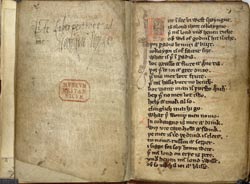|
|
The
Land of Cockaygne
London, British Library, MS Harley 913, ff. 3r-6v
Introduction
The
manuscript
 This poem survives in only one manuscript, London, British Library, Harley
MS 913, a small (less than 6 x 4 inches), unadorned, and scruffy
collection of various items in different hands and in different languages
(Middle English, French, and Latin). Click on the
image to the right for larger images of the opening of the poem.
This poem survives in only one manuscript, London, British Library, Harley
MS 913, a small (less than 6 x 4 inches), unadorned, and scruffy
collection of various items in different hands and in different languages
(Middle English, French, and Latin). Click on the
image to the right for larger images of the opening of the poem.
It was probably
compiled in Ireland in the early 1330s. There is some internal evidence
for Franciscan origin: one poem is said to have been written by Friar
Michael of Kildare, and the MS includes some specifically Franciscan
material. The small format of the MS suggests a friar's pocket-book
(friars went on foot, and needed to travel light). A few of the Middle
English items, like Cockaygne itself and the long drinking song
(making fun of local clerics and tradesmen) which follows it, were clearly
for amusement; but most of the Middle English content is didactic, verse
sermons and lyrics designed for the instruction of the laity.
The
Land of Cockaygne
The Land of Cockaygne is a fictional and parodic otherworld, drawing on
three main traditions:
1. Classical tradition: going back to Lucian's True History,
a Greek work of the second century AD, which describes a comically
paradisal land full of food, drink, and loose women.
2. Christian tradition: descriptions of both Heaven and the Earthly
Paradise, the garden from which Adam and Eve were expelled, which was seen
as a real, though remote, place on earth, visited by Alexander the Great.
It was often placed far to the East (although Dante in his Divine
Comedy locates it in the Antipodes, at the tip of the mountain of
Purgatory).
3. Goliardic verse: one Latin poem of the twelfth century (Carmina
Burana 222) is spoken by an abbas Cucaniensis, an 'abbot of
Cockaygne' who presides over drinking and gambling, and the descriptions
of the two abbeys in Cockaygne, which invert the usual norms of
religious life, echo themes found elsewhere in Goliardic poetry (e.g. the
description of the ordo vagorum in Cum in orbem universum,
Carmina Burana 219). This strand seems to be distinctive to the poem
in Harley 913 (which also includes some Goliardic verse); it does not
appear in the surviving Old French and Middle Dutch poems on the same
theme (see V. Vaananen, 'Le "fabliau" de Cocagne', Neuphilologische
Mitteilungen 48 (1947), 3-36; texts and translations of the Dutch
versions are included in Herman Pleij, Dreaming of Cockaigne: Medieval
Fantasies of the Perfect Life [1997], trs. Diane Webb (NY: Columbia
UP, 2001)).
The
translation
The
translation is based (with a couple of exceptions, discussed in the notes)
on the edited text in J. A. Bennett and G. V. Smithers, Early Middle
English Verse and Prose, 2nd edn (Oxford: Clarendon Press, 1968); you
are recommended to consult also its comprehensive notes and Glossary. For
an on-line text of the Middle English original, see the CELT (Corpus of
Electronic Texts) edition at http://www.ucc.ie/celt/published/E300000-001/
(this also includes the other Middle English poems in the manuscript, with
a full bibliography). There are also interleaved texts and translations of
the poems 'in Angela M. Lucas, ed., Anglo-Irish Poems of the
Middle Ages (Blackrock: Columba Press, 1995).

|
